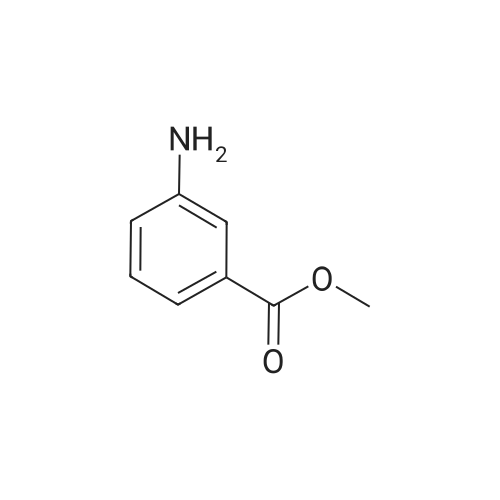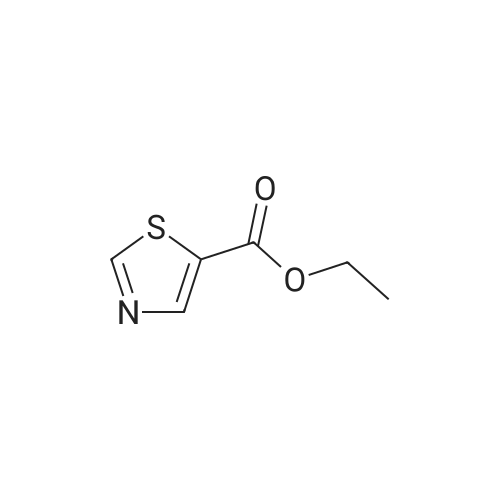| 91% |
With potassium tert-butylate; In tetrahydrofuran; di-isopropyl ether; at 0 - 20℃; for 24.3333h;Inert atmosphere; |
To a stirred solution of ethyl 2-chloroacetate 95 (5 g, 40.98 mmol) and ethyl formate (3.33 mL, 40.98 mmol) in diisopropyl ether (50 mL) under Ar atmosphere was added potassium tert-butoxide (45 mL, 45.08 mmol, 1 M sol. in THF) portion wise for 20 min at 0 oC, followed by warming to room temperature and stirring for 24 h. The reaction was monitored by TLC. After completion of the reaction, the pH of the reaction mixture was adjusted to ~ 6 using 6 N HCl and extracted using diethyl ether. The combined organic extracts were dried over anhydrous sodium sulfate and concentrated in vacuo to afford compound 96 (5.6 g, 91%) as thick syrup. TLC: 40% EtOAc/ hexanes (Rf: 0.7); 1H-NMR (DMSO-d6, 400 MHz): delta 11.75 (br.s, 1H), 4.14 (q, J = 7.0 Hz, 2H), 4.05 (s, 1H), 1.21 (t, J = 7.1 Hz, 3H). |
| 88% |
With sodium ethanolate; In toluene; at 0 - 20℃; for 17h; |
Synthesis of Compound A.3. Ethyl chloroacetate (50 g, 0.409 mol) and ethyl formate (30.3 g, 0.409 mol) were taken in anhydrous toluene (500 mL) and cooled to 0 C. NaOEt (33 g, 0.485 mol) was added portion wise. The reaction mixture was stirred at 0 C. for 5 hr and then at RT for 12 hr. The reaction mixture was quenched with water (250 mL) and washed with Et2O (2×250 mL). The aqueous layer was cooled to 0 C. and acidified to pH 4 using 5N HCl. The aqueous layer was extracted with Et2O (3×300 mL). The combined organic layers were dried (Na2SO4) and concentrated under reduced pressure to obtain compound A.3 as light brown oil (54 g, 88%), which was used without further purification. |
| 88% |
With ethanol; sodium; In toluene; at 0 - 20℃; for 17h; |
Ethyl chloroacetate (50 g, 0.409 mol) and ethyl formate (30.3 g, 0.409 mol) were taken in anhydrous toluene (500 mL) and cooled to 0 C. NaOEt (33 g, 0.485 mol) was added portion wise. The reaction mixture was stirred at 0 C. for 5 hr and then at RT for 12 hr. The reaction mixture was quenched with water (250 mL) and washed with Et2O (2×250 mL). The aqueous layer was cooled to 0 C. and acidified to pH 4 using 5N HCl. The aqueous layer was extracted with Et2O (3×300 mL). The combined organic layers were dried (Na2SO4) and concentrated under reduced pressure to obtain compound A.3 as light brown oil (54 g, 88%), which was used without further purification. |
| 73.3% |
With sodium ethanolate; In toluene; at 0 - 20℃; for 17h; |
To a solution of ethyl 2-chloroacetate (5.0 g, 40.9 mmol) and ethyl formate (3.0 g, 40.9 mmol) in toluene (100 mL) was added sodium ethoxide (3.3 g, 48.5 mmol) at 0 C. The reaction mixture was stirred at 0 C. for 5 hours, the mixture was warmed up to room temperature stirred for 12 hours. The mixture was quenched with ice water (200 mL), extracted with Ether, washed with brine, dried with anhydrous Na2SO4, filtered and concentrated to give the crude product. The crude product was purified by silica gel chromatography eluted to give product 1-2 (4.5 g, 73.3%). MS m/z [ESI]: 151.0 [M+1]. |
| 71% |
With potassium tert-butylate; In tetrahydrofuran; at -78 - 0℃; for 4h; |
A mixture of ethyl formate (3.3 mL, 41 mmol) and ethyl 2-chloroacetate (3.5 mL, 41 mmol) in THF (80 mL) was cooled to -78 C. To this mixture was added potassium t-butoxide (81 mL, 81 mmol) slowly such that the temperature of the reaction stayed below -68 C. After the addition was complete, the reaction mixture was stirred at -78 C for 1 h and was then warmed to 0 C and was stirred for an additional 3 h. The reaction mixture was quenched at 0 C with 1 N HC1 (30 mL), and then cautiously acidified to pH 4 with cone. HC1 (ca. 5 mL). The mixture was transferred to a separatory funnel containing water (30 mL). Solid sodium chloride was added and the aqueous layer was extracted with ether (3 x 150 mL). The combined organic layers were washed with brine, dried over Na2S04, filtered, concentrated and placed under vaccum to afford ethyl 2-chloro-3-oxopropanoate (4.3 g, 71% yield) as a pale-yellow oil which was directly in the next step |
| 68% |
|
A flame-dried IL 3-neck round bottom flask equipped with an addition funnel and a condenser was charged with dry toluene (45 mL). Sodium metal chunks (8.34 g, 363 mmol, 1.1 equiv) were added, and the mixture was heated to reflux (bath temp. 115 0C). Dry absolute ethanol (30 mL) was added slowly by addition funnel over 30 minutes. The reaction mixture was stirred at 115 0C for an addition 2 hours, then cooled to room temperature. The cooled sodium ethoxide suspension was diluted with ethyl ether (200 mL), then the addition funnel was charged with ethyl chloroacetate (35.3 mL, 330 mmol, 1.0 equiv), ethyl formate (27.0 mL, 330 mmol, 1.0 equiv), and ethyl ether (25 mL). The ethyl chloroacetate / ethyl formate mixture was added slowly over 2.5 hours, and the resultant pale yellow suspension was stirred at room temperature overnight. The reaction mixture was cooled to 0C, and H2O (150 mL) was gradually added. After separation of the EPO <DP n="116"/>phases, the aqueous layer was acidified to pH 3 with aqueous 1 N HCl (300 mL), and extracted with ether (6 x 80 mL). The combined organic layers were washed with brine (300 mL), dried over anhydrous sodium sulfate, and concentrated in vacuo. The brownish-red crude oil was purified by distillation under reduced pressure to afford compound 13.2 as a colorless oil (33 g, 68%; lit. boiling point 60 0C (at) 12 torr). |
| 40% |
With potassium ethoxide; In diethyl ether; ethanol; at 20℃; |
STEP 1 A solution of ethyl formate (38 mL, 470 mmol) and ethyl chloroacetate (44 mL, 416 mmol) in diethyl ether (200 mL) was added to an ice-cold solution of potassium ethoxide (33.5 g, 400 mmol) in 1:2 ethyl alcohol/diethyl ether (300 mL). The suspension was stirred overnight at room temperature. The solid was filtered, washed with diethyl ether, and dissolved in water. The solution was cooled in an ice bath and acidified to pH 4 with concentrated HCl. The solution was extracted with diethyl ether, washed with saturated NaCl, dried (sodium sulfate), filtered, and concentrated under reduced pressure yielding formylchloroacetate 31-1 (24.2 g, 40%) as a yellow oil: 1H NMR (300 MHz, CDCl3) delta 4.99-4.19 (m, 2H), 4.08 (s, 1H), 3.64-3.57 (m, 1H), 1.35-1.18 (m, 3H). |
| 19% |
With sodium ethanolate; In toluene; at 0 - 20℃; for 17h; |
To a solution of ethyl chloroacetate (50.0 g, 0.409 mol) and ethyl formate (30.3 g, 0.409 mol) in toluene (500 mL) at 0 C was added sodium ethoxide (33.0 g, 0.49 mol). The reaction mixture was stirred at 0C for 5 hours and then at ambient temperature for 12 hours. The reaction mixture was quenched with water (250 mL), and extracted with ether (2 x 250 mL). The aqueous layer was cooled to 0 C and acidified to pH 4 with 5N hydrochloric acid solution. The aqueous layer was then extracted with ether (3 x 300 mL) and the combined organic extracts were dried over sodium sulfate, filtered, and concentrated under reduced pressure to furnish the title compound (20.0 g, 19 %) as a light brown oil. The compound was used in the next step without further purification. |
| 15.44% |
With ethanol; sodium; In diethyl ether; at 20℃; |
To a flask was added sodium (4.45 g, 194 mmol) and ethanol (56.5 mL, 968 mmol) and the mixture was stirred at room temperature for 4 hours until all of the metal had dissolved. Diethyl ether (100 mL) was added, followed by the slow addition of a solution of ethyl formate (17.20 mL, 213 mmol) and ethyl chloroacetate (22.79 mL, 213 mmol) in diethyl ether (100 mL). The reaction solution was stirred at room temperature for 16 hours. The resulting precipitate that formed was filtered and washed with ether, and dissolved in water. The aqueous layer was acidified with HCl (IN) to pH 4 and the product was extracted with diethyl ether (3x). The organic layers were combined, dried over anhydrous sodium sulfate and concentrated to give ethyl 2-chloro-3-oxopropanoate (4.5 g, 29.9 mmol, 15.44 % yield). |
| 15.4% |
|
IB: Preparation of ethyl 2-chloro-3-oxopropanoate[00229] To a flask was added sodium (4.45 g, 194 mmol) and ethanol (56.5 mL, 968 mmol) and the mixture was stirred at room temperature for 4 hours until all of the metal had dissolved. Diethyl ether (100 mL) was added, followed by the slow addition of ethyl formate (17.2 mL, 213 mmol) and ethyl chloroacetate (22.79 mL, 213 mmol) as a solution in diethyl ether (100 mL). The reaction solution was stirred at room temperature for 16 hours. The resulting precipitate that formed was filtered and washed with ether, and dissolved in water. The aqueous layer was acidified with HCl (IN) to pH 4, and the product was extracted with diethyl ether (3 times). The organic layers were combined, dried over anhydrous sodium sulfate and concentrated to give IB (4.5 g, 15.4 % yield). |
|
In tetrahydrofuran; |
A. Ethyl 2-Chloro-2-formylacetate To a three neck 2 L round bottom flask charged with potassium t-butoxide (0.5 mol, 500 mL of a 1M solution in THF) and 500 mL of dry THF cooled to 0 C. was added dropwise from an addition funnel a solution of ethyl chloroacetate (0.5 mol, 53.5 mL) and ethyl formate (0.5 mol, 40.4 mL), in 200 mL of THF over 3 hours. After completion of addition, the reaction mixture was stirred for 1 hour and allowed to stand overnight. The resulting solid was diluted with diethyl ether and cooled in an ice bath. |
|
In tetrahydrofuran; |
N. Ethyl 2-Chloro-2-formylacetate To a three neck 2 L round bottom flask charged with potassium t-butoxide (0.5 mol, 500 mL of a 1 M solution in THF) and 500 mL of dry THF cooled to 0 C. was added dropwise from an addition funnel a solution of ethyl chloroacetate (0.5 mol, 53.5 mL) and ethyl formate (0.5 mol, 40.4 mL), in 200 mL of THF over 3 hours. After completion of addition, the reaction mixture was stirred for 1 hour and allowed to stand overnight. The resulting solid was diluted with diethyl ether and cooled in an ice bath. |
|
In tetrahydrofuran; |
I. Ethyl 2-Chloro-2-formylacetate To a three neck 2 L round bottom flask charged with potassium t-butoxide (0.5 mol, 500 mL of a 1M solution in THF) and 500 mL of dry THF cooled to 0 C. was added dropwise from an addition funnel a solution of ethyl chloroacetate (0.5 mol, 53.5 mL) and ethyl formate (0.5 mol, 40.4 mL), in 200 mL of THF over 3 hours. After completion of addition, the reaction mixture was stirred for 1 hour and allowed to stand overnight. The resulting solid was diluted with diethyl ether and cooled in an ice bath. |
|
In tetrahydrofuran; |
I. Ethyl 2-Chloro-2-formylacetate. To a three neck 2 L round bottom flask charged with potassium t-butoxide (0.5 mol, 500 mL of a 1M solution in THF) and 500 mL of dry THF cooled to 0 C. was added dropwise from an addition funnel a solution of ethyl chloroacetate (0.5 mol, 53.5 mL) and ethyl formate (0.5 mol, 40.4 mL), in 200 mL of THF over 3 hours. After completion of addition, the reaction mixture was stirred for 1 hour and allowed to stand overnight. The resulting solid was diluted with diethyl ether and cooled in an ice bath. |
|
In tetrahydrofuran; |
B. Ethyl 2-Chloro-2-formylacetate To a three neck 2 L round bottom flask charged with potassium t-butoxide (0.5 mol, 500 mL of a 1M solution in THF) and 500 mL of dry THF cooled to 0 C. was added dropwise from an addition funnel a solution of ethyl chloroacetate (0.5 mol, 53.5 mL) and ethyl formate (0.5 mol, 40.4 mL), in 200 mL of THF over 3 hours. After completion of addition, the reaction mixture was stirred for 1 hour and allowed to stand overnight. The resulting solid was diluted with diethyl ether and cooled in an ice bath. |
|
With sodium ethanolate; In toluene; at 0 - 20℃; |
Ethyl chloroacetate (50 g, 0.409 mol) and ethyl formate (30.3g, 0.409 mol) were taken in anhydrous toluene (500 mL) and cooled to 0 C. NaOEt (33g, 0.485 mol) was added portion wise. The reaction mixture was stirred at 0 C for 5 hr and then at room temperature for 12 hr. The reaction mixture was quenched with water (250 mL) and washed with Et2O (2 x 250 mL). The aqueous layer was cooled to 0 C and acidified to pH 4 using 5N HCl. The aqueous layer was extracted with Et2O (3 x 300 mL). The combined organic layers were dried (Na2SO^ and concentrated under reduced pressure to obtain compound G.2 as light brown oil (54 g, 88%), which was used without further purification. |
|
|
A mixture of ethyl formate (385 g, 5.20mol) and ethyl chloroacetate (640 g, 5.20mol) was added to a suspension of potassium t- butoxide (583 g, 5.2mol) in diisopropyl ether (5 L) at 0 C, and the resulting mixture was stirred for 24 h at room temperature. Then the pH of the solution was adjusted to pH=6 with concentrated sulfuric acid. The solid was filtered and the filtrate was concentrated under reduced pressure to afford ethyl 2-chloro-3-oxopropanoate (18- A) as oil. |
|
With sodium ethanolate; In toluene; at 0 - 20℃; |
Step 1: Intermediate 29-b Ethyl chloroacetate, 29-a (50.0 g, 0.41 mol), and ethyl formate (30.2 g, 0.41 mol) were taken in anhydrous toluene (500 ml_) and cooled to 0C. Sodium ethoxide (35.1 g, 0.49 mol) was added portion wise. The reaction mixture was stirred at 0C for 5 hours and then at room temperature overnight. The reaction mixture was quenched with water (250 mL) and washed twice with diethyl ether. The aqueous layer was cooled to 0 C and acidified to pH 4-5 using 1 N HCI. The aqueous layer was extracted twice with diethyl ether; the combined organic layers were dried over MgS04 filtered and concentrated under reduced pressure to provide intermediate 29-b as beige oil. |
|
With sodium ethanolate; In toluene; at 0 - 20℃; for 5h; |
Ethyl chloroacetate (50.0 g, 0.41 mol) and ethyl formate (30.2 g, 0.41 mol) were dissolved in anhydrous toluene (500 mL) and cooled to 0C. Sodium ethoxide (35.1 g, 0.49 mol) was added portion wise. The reaction mixture was stirred at 0C for 5 hours and then at room temperature overnight. The reaction mixture was quenched with water (250 mL) and washed twice with diethyl ether. The aqueous layer was cooled to 0 C and acidified to pH 4-5 using iN aqueous HCI. The aqueous layer was extracted twice with diethyl ether and the combined organic extracts were dried over MgSO4, filtered and concentrated under reduced pressure to provide intermediate 7-b as a beige oil. |
|
With sodium ethanolate; In toluene; at 0 - 20℃; |
Step 1: Intermediate 5-b: Ethyl chloroacetate (50.0 g, 0.41 mol) and ethyl formate (30.2 g, 0.41 mol) were taken in anhydrous toluene (500 mL) and cooled to 0C. Sodium ethoxide (35.1 g, 0.49 mol) was added portion wise. The reaction mixture was stirred at 0 C for 5 hours and then at room temperature overnight. The reaction mixture was quenched with water (250 mL) and washed twice with diethyl ether. The aqueous layer was cooled to 0 C and acidified to pH 4-5 using 1 N HCI. The aqueous layer was extracted twice with diethyl ether; the combined organic layers were dried over MgSO4 filtered and concentrated under reduced pressure to provide intermediate 5-b as beige oil |
|
With hydrogenchloride; sodium ethanolate; In diethyl ether; ethanol; at 20℃; |
Example 29A Ethyl 2-chloro-3-oxopropanoate 139 ml of a 21% strength solution of sodium ethoxide in ethanol (371 mmol, 0.91 equivalents) were initially charged in 200 ml of diethyl ether, and a solution consisting of 43.7 ml of ethyl chloroacetate (408 mmol, 1 equivalent) and 32.9 ml of ethyl formate (408 mmol, 1 equivalent) in 150 ml of diethyl ether was added dropwise at RT. The reaction mixture was stirred overnight and the solid was filtered off and washed with diethyl ether. The solid was dissolved in water and the aqueous phase was, with ice bath cooling, adjusted to pH4 using concentrated hydrochloric acid. The mixture was extracted repeatedly with diethyl ether and the combined organic phases were washed with saturated aqueous sodium chloride solution, dried with magnesium sulphate, filtered and concentrated. The crude product obtained (8.2 g) was freed from residual solvent under high vacuum and used without further purification for the next reaction. |
|
With sodium ethanolate; In diethyl ether; ethanol; at 20℃; |
Example 26A Ethyl 2-chloro-3-oxopropanoate 139 ml of a 21% strength solution of sodium ethoxide in ethanol (371 mmol, 0.91 equivalent) were initially charged in 200 ml of diethyl ether, and a solution of 43.7 ml of ethyl chloroacetate (408 mmol, 1 equivalent) and 32.9 ml of ethyl formate (408 mmol, 1 equivalent) in 150 ml of diethyl ether was added dropwise at RT. The reaction mixture was stirred overnight and the solid was filtered off and washed with diethyl ether. The solid was dissolved in water and the aqueous phase was, with ice bath cooling, adjusted to pH4 using concentrated hydrochloric acid. The mixture was extracted repeatedly with diethyl ether and the combined organic phases were washed with saturated aqueous sodium chloride solution, dried with magnesium sulphate, filtered and concentrated. The crude product obtained (8.2 g) was freed from residual solvent under high vacuum and used without further purification for the next reaction. |
|
With sodium ethanolate; In toluene; at 0 - 20℃; |
Step 1: Intermediate 29-b [0170] Ethyl chloroacetate, 29-a (50.0 g, 0.41 mol), and ethyl formate (30.2 g, 0.41 mol) were taken in anhydrous toluene (500 mL) and cooled to 0 C. Sodium ethoxide (35.1 g, 0.49 mol) was added portion wise. The reaction mixture was stirred at 0 C. for 5 hours and then at room temperature overnight. The reaction mixture was quenched with water (250 mL) and washed twice with diethyl ether. The aqueous layer was cooled to 0 C. and acidified to pH 4-5 using 1 N HCl. The aqueous layer was extracted twice with diethyl ether; the combined organic layers were dried over MgSO4 filtered and concentrated under reduced pressure to provide intermediate 29-b as beige oil. |
| 6 g |
With potassium tert-butylate; In di-isopropyl ether; at 20℃; for 24.16h;Inert atmosphere; |
[000234] Synthesis of ethyl 2-chloro-3-oxopropanoate (286): To a stirred solution of ethyl 2- chioroacetate 284 (5 g, 40.98 mmol) and 285 (3.03 g, 40.98 mmol) in diisopropyl ether (100 mL) under argon atmosphere was added potassium tert-butoxide (5.49 g, 45.08 mmol) portion wise for 10 mm at 0 C; warmed to RT and stirred for 24 h. The reaction was monitored by TLC; after completion of the reaction, the pH of the reaction mixture was adjusted to 6 using 5 N HC1. The obtained solid was filtered, washed with diethyl ether (200 mL) and dried in vacuo to afford compound 286 (6 g) as pale brown syrup. TLC: 30% EtOAc/ hexanes (R 0.2); LC-MS:21.49% + 75.58%; 149.0 (Mtl); (column; X-Select C-18, (50 x 3.0 mm, 3.5 jim); RT 0.56 mm,0.77 mm. 5 Mm Aq.NH4OAc: ACN 0.8 mL/min). |
| 8.2 g |
With hydrogenchloride; sodium ethanolate; In diethyl ether; ethanol; at 20℃; |
Example 30A Ethyl 2-chloro-3-oxopropanoate 139 ml of a 21% strength sodium ethoxide solution in ethanol (371 mmol, 0.91 equivalent) were initially charged in 200 ml of diethyl ether, and a solution of 43.7 ml of ethyl chloroacetate (408 mmol, 1 equivalent) and 32.9 ml of ethyl formate (408 mmol, 1 equivalent) in 150 ml of diethyl ether was added dropwise at RT. The reaction mixture was stirred overnight and the solid formed was filtered off and washed with diethyl ether. The solid was dissolved in water and the aqueous phase was, with ice-bath cooling, adjusted to pH 4 using concentrated hydrochloric acid. The mixture was repeatedly extracted with diethyl ether and the combined organic phases were washed with saturated aqueous sodium chloride solution, dried with magnesium sulphate, filtered and concentrated. The crude product obtained (8.2 g) was freed from residual solvent under high vacuum and used for the subsequent reaction without further purification. |
|
With sodium ethanolate; |
Example 30A Ethyl 2-chloro-3-oxopropanoate 139 ml of a 21% strength sodium ethoxide solution in ethanol (371 mmol, 0.91 equivalent) were initially charged in 200 ml of diethyl ether, and a solution of 43.7 ml of ethyl chloroacetate (408 mmol, 1 equivalent) and 32.9 ml of ethyl formate (408 mmol, 1 equivalent) in 150 ml of diethyl ether was added dropwise at RT. The reaction mixture was stirred overnight and the solid formed was filtered off and washed with diethyl ether. The solid was dissolved in water and the aqueous phase was, with ice-bath cooling, adjusted to pH 4 using concentrated hydrochloric acid. The mixture was repeatedly extracted with diethyl ether and the combined organic phases were washed with saturated aqueous sodium chloride solution, dried with magnesium sulphate, filtered and concentrated. The crude product obtained (8.2 g) was freed from residual solvent under high vacuum and used for the subsequent reaction without further purification. |
|
With potassium tert-butylate; at 0 - 20℃; for 16h; |
To a suspension of potassium tert-butaoxide (16.4g, l46mmol) in Et20 (300mL) at 0 00 was added a mixture of ethyl 2-chloroacetate (15g, l22mmol) and ethyl formate(9g, l22mmol) in Et20 (5OmL) slowly. The reaction was further stirred at rt for 16h. TLC showed the reaction to be complete. The precipitated solid was filtered and washed with Et20 (lOOmL). The solid was added to ice-cold H20 (200mL), acidified to pH 5-6 with 1.0 N HCI and extracted with Et20 (3x200mL). The organics layer was washed with brine (lOOmL), dried (Na2SO4), filtered and concentrated under reduced pressure to afford ethyl 2-chloro-3-oxopropanoate as a yellow oil, which was used in next step without further purification. |
| 6 g |
With potassium tert-butylate; In di-isopropyl ether; at 0 - 20℃; for 24.1667h;Inert atmosphere; |
To a stirred solution of ethyl 2-chloroacetate 59 (5 g, 40.98 mmol) and 60 (3.03 g,40.98 mmol) in diisopropyl ether (100 mL) under argon atmosphere was added potassium tert20 butoxide (5.49 g, 45.08 mmol) portion wise for 10 mm at 0 C; warmed to RT and stirred for 24h. The reaction was monitored by TLC; after completion of the reaction, the pH of the reaction mixture was adjusted to 6 using 5 N HC1. The obtained solid was filtered, washed with diethyl ether (200 mL) and dried in vacuo to afford compound 61 (6 g) as pale brown syrup. TLC: 30% EtOAc/ hexanes (R 0.2); LC-MS: 21.49% + 75.58%; 149.0 (M-1); (column; X-Select C-18, (50 x 3.0 mm, 3.5 jim); RT 0.56 mm, 0.77 mm. 5 Mm Aq.NH4OAc: ACN 0.8 mL/min). |
| 6 g |
With potassium tert-butylate; In di-isopropyl ether; at 0 - 20℃; for 24h;Inert atmosphere; |
To a stirring solution of ethyl 2-chloroacetate 2-1 (5 g, 40.98 mmol) and ethylformate (3.03 g, 40.98 mmol) in diisopropyl ether (100 mL) under argon atmosphere wasadded potassium tert-butoxide (5.49 g, 45.08 mmol) portion wise for 10 mm at 0 C; warmed to RT and stirred for 24 h. The reaction was monitored by TLC; after completion of the reaction, the pH of the reaction mixture was adjusted to - 6 using 5 N HC1. The obtained solid was filtered, washed with diethyl ether (200 mL) and dried in vacuo to afford compound2-2 (6 g) as pale brown syrup. TLC: 30% EtOAc/ hexanes (R 0.2); LC-MS: 21.49% +75.58%; 149.0 (M-1); (column; X-Select C-18, (50 x 3.0 mm, 3.5 pm); RT 0.56 mm, 0.77 mm. 5 Mm Aq.NH4OAc: ACN 0.8 mL/mmn) |
|
With sodium ethanolate; In toluene; at 0 - 20℃; for 17h; |
[0507] To a solution of ethyl chloroacetate (50.0 g, 0.409 mol) and ethyl formate (30.3 g, 0.409 mol) in toluene (500 mL) at 0 C was added sodium ethoxide (33.0 g, 0.49 mol). The reaction mixture was stirred at 0C for 5 hours and then at ambient temperature for 12 hours. The reaction mixture was quenched with water (250 mL), and extracted with ether (2 250 mL). The aqueous layer was cooled to 0 C and acidified to pH 4 with 5N hydrochloric acid solution. The aqueous layer was then extracted with ether (3 300 mL) and the combined organic extracts were dried over sodium sulfate, filtered, and concentrated under reduced pressure to furnish the title compound (20.0 g, 19 %) as a light brown oil. The compound was used in the next step without further purification.1H NMR (400 MHz, DMSO- d6) delta 1.21 (t, J = 7.1Hz, 3H), 4.14 (q, J = 7.1Hz, 2H), 7.94 (s, 1H), 11.74 (br.s, 1H). |

 Chemistry
Chemistry
 Pharmaceutical Intermediates
Pharmaceutical Intermediates
 Inhibitors/Agonists
Inhibitors/Agonists
 Material Science
Material Science













 HazMat Fee +
HazMat Fee +

 For Research Only
For Research Only
 120K+ Compounds
120K+ Compounds
 Competitive Price
Competitive Price
 1-2 Day Shipping
1-2 Day Shipping
















